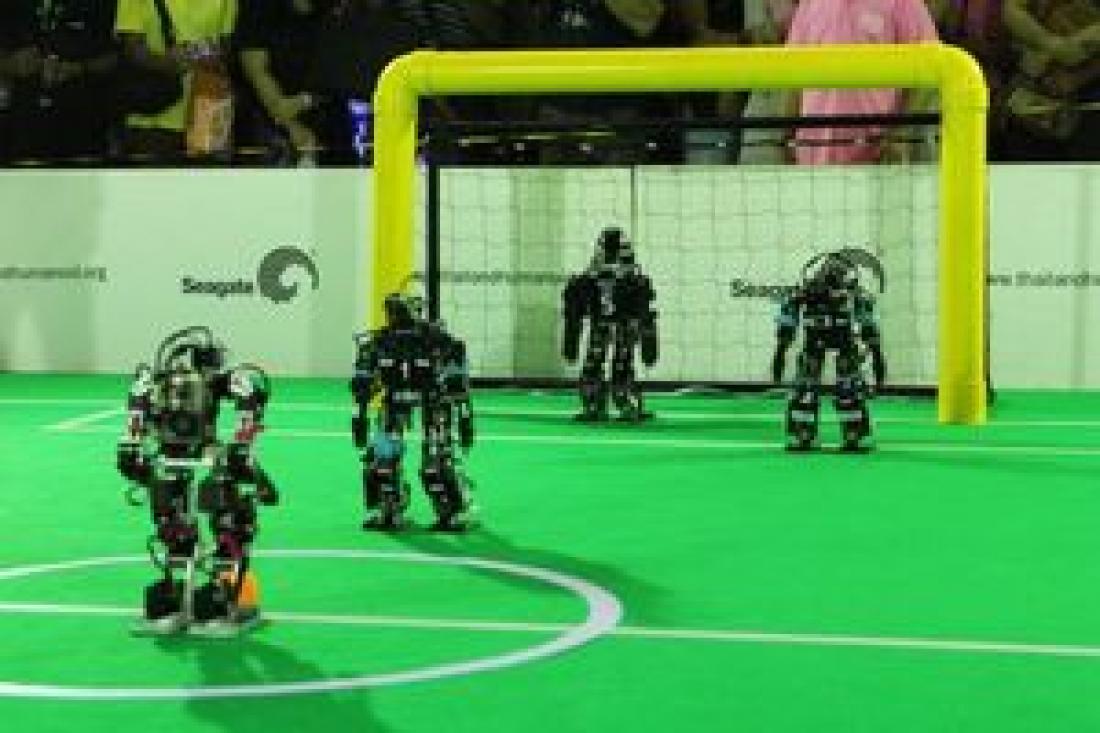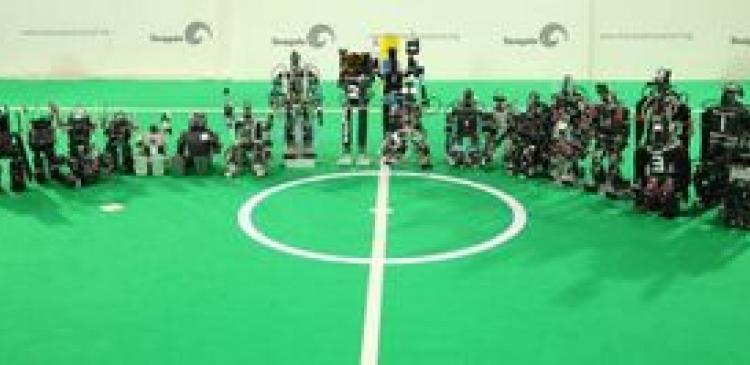Seagate supported the Thailand Humanoid Robot Soccer Championship, in which students designed their own soccer-playing machines. Hanuman Team from King Mongkut’s University of Technology Thonburi (KMUTT) emerged as champions of this year’s competition. The team won a cash prize of 200,000 baht and will represent Thailand at the World Robocup Soccer Humanoid League 2013 in Osaka, Japan, next year. Thanyaburi Tonkla Team from Rajamangala University of Technology Thanyaburi (RMUTT) 100,000 baht as the first runners-up.
Thailand’s Humanoid Robot Soccer Championship 2012 was jointly organized by Seagate Technology (Thailand) Limited, the Thai Robotics Society (TRS), FIBO of King Mongkut’s University of Technology Thonburi and the National Electronics and Computer Technology Center (NECTEC). This year saw 11 teams from 8 universities battling for the chance to represent Thailand in the World Robocup Soccer Humanoid League 2013.
“TRS is confident that these competitions foster hands-on technical learning and collaboration—which are key qualities for success in our digital world,” said Dr. Thavida Maneewan, president of the Thai Robotics Society. “Students exchange ideas and valuable experiences with one another, which ultimately benefits them and our society.”
“NECTEC is pleased to support Thai university students in using knowledge gained from their classrooms and applying it in a creative competition such as this one,” added Dr. Pansak Siriruchtapong, executive director of National Electronics and Computer Technology Center(NECTEC) “We hope that the Humanoid Robot Soccer contest will also emphasize the importance of technology in helping further our country’s innovation and economic future.”
“We hope that the Humanoid Robot Soccer contest will also emphasize the importance of technology to enhance their learning and skills development and increase innovation capability for young Thai people”.
This was Seagate’s third year as the main sponsor for this event; Seagate contributed 1.7 million baht to this year’s contest.
“People learn best in a fun, challenging and collaborative environment,” said Mr. Jeffrey D. Nygaard, vice president and country manager, Thailand & Penang Operations, Seagate Technology (Thailand) Limited.” What is exciting for me is to see how the students improve and tweak their robots after each match. That’s the kind of continuous improvement and focus on quality that any high-technology company values.”
An interview given by Mr. Wisanu Jutharee, master’s degree student of FIBO, Robotics and Automation, King Mongkut’s University of Technology Thonburi (KMUTT) who is team leader of “Hanuman FC”, King Mongkut’s University of Technology Thonburi (KMUTT). The team wins the Thailand Humanoid Robot Soccer Championship 2012
1. How does this year’s contest help to develop skills of Hanuman FC team members?
All of us have never had any experience in joining this contest. That’s why our first experience in joining this nationwide contest helps to develop almost all of the necessary skills required for robot development. We have been able to develop many skills including the robotic structure, electronic system design and computer programming. This contest sharpens our teamwork skill as well. These are skills taught by our lecturers and our seniors.
2. How long does it take for the team preparation before the final round contest kicks off?
Actually it takes us about 1 month in the preparation phase since the majority of our team members need to attend several classes, complete their thesis and submit their class projects. We take our free time each day to complete all things. Then, we combine these systems together and test the whole of them before the final round kicks off.
3. Can you explain how the Humanoid robot soccer works?
There are 3 main components of Humanoid robot soccer. The first part is the vision. The second part is the brain and the third part is the robot movement control. Our robots see things through webcams used to capture various pictures around them. So, webcam is like human eyes so that robots can look what are surrounding them. Then, they will send the recorded pictures for further data processing at their brain. Small PCs are like robot brains. These PCs need to carry on the data processing and make all robots decision. Then, the command will be sent to the last part which is the robot movement control. These commands make the robot move.
4. Which type of robotic developments are needed to be prepared for the World Robocup 2013 next year?
Three things are essential for us to compete with world-class teams. First thing is about stable and fast movement. Secondly, identification of robot position in the field. And the last thing is to make these three robots work best in their team. That’s why we need to make sure each robot knows when it should play the ball and when it should wait for the ball from its team members.
5. How much does the team expect from representing Thailand in World Robocup 2013 next year?
It’s difficult to be the Final Four as these four teams are usually the world’s leading Humanoid robot soccer teams. These are high potential teams due to their tremendous human resources and funding. So, our target for next year contest is to be one of the four finalist teams.
6. What are your encouragement for the new generation of Thai university student who are interested in developing their own Humanoid robots?
The Humanoid robot soccer is the most difficult and challenging league. However, it’s fun and brings great pride for developers. As a robot developer, seeing our robots movement is our success. Some important things are dedication and transfer of knowledge to the next generation. It takes KMUTT many years until we reach our current development status today. So, we would like to encourage the new generation of Thai university students to stay committed to their goals. Then, great success will be yours.
---
About TRS
Thai Robotics Society (TRS) was established in 2000 by groups of roboticians, researchers, and industrial people, involving in robotic education and application. They are interested in developing technology and research in robotics as well as some robotic related activities in the Kingdom of Thailand. You may reach the Thai Robotics Society by calling 0-2889-2138 extension 6446 or visit www.trs.or.th (links below)
---
About NECTEC
The National Electronics and Computer Technology Center (NECTEC) is a statutory government organization under the National Science and Technology Development Agency (NSTDA), Ministry of Science and Technology. Its main responsibilities are to undertake, support and promote the development of electronics and computer technologies through
research and development activities. NECTEC also provides linkage between research communities and industries through the established industrial clusters.
NECTEC Vision “Being a core organization collaborating with alliances in R&D of electronics and computer technologies for strengthening sustainability of Thai industries and sufficiency society.”
---
About Seagate
Seagate is the worldwide leader in hard disk drives and storage solutions.
---
Press Release via Thailand4.com




